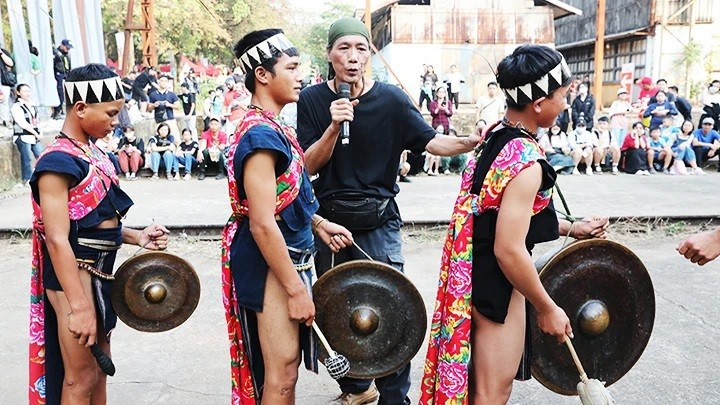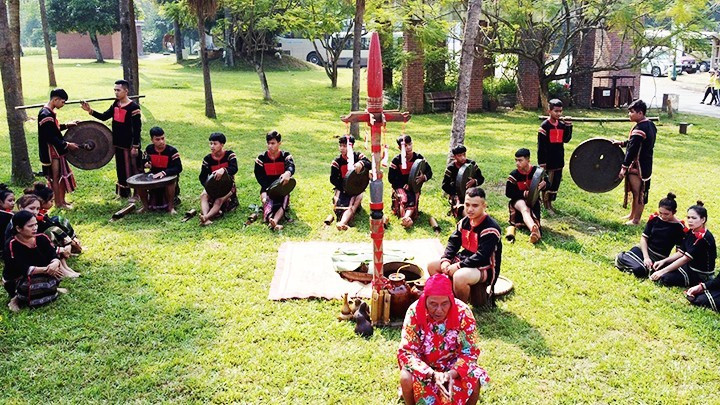Preserving the Central Highlands gong culture requires the cooperation of the community, the government, artisans and today's young generation on the basis of correct, scientific methods, suitable for development trends.

Music researcher Bui Trong Hien interprets gong scales for the public at the Hanoi Creative Design Festival 2023.
(Continued and end)
According to the original element… find back
Sharing the difficulties in preserving and maintaining the cultural space of the Central Highlands gongs after 20 years of being recognized by UNESCO, Head of the Cultural Management Department, Department of Culture, Sports and Tourism (VHTT&DL) Kon Tum Dau Ngoc Hoai Thu said that from a professional perspective, it can be seen that the sacredness of gongs is no longer as strong as before. The most worrying issue today is the modernization of the gong sound system. Gongs are played according to the average scale (do, re, mi...). In addition, many agencies and departments participate in the work of preserving gong culture. Each unit and individual chooses a different approach. Without expertise, ancient gong songs will inadvertently be lost.
Scale is the fundamental element that creates the uniqueness in the sound of the Central Highlands gongs. Playing the wrong scale or mixing the scales of different ethnic groups leads to the disappearance of the standard scale. More than 20 years ago, when participating in the dossier on the cultural space of gongs for the UNESCO program, music researcher Bui Trong Hien was surprised by the diversity and richness of the separate scale systems in the gong sets of the Ba Na, Gia Rai, Xo Dang... But in 2022, when judging the Gong Festival organized by the Department of Culture, Sports and Tourism of Kon Tum, he was "shocked" to find that almost all the gong sets played the wrong scale. The phenomenon of "hybrid sounds" is widespread, the Xo Dang gong set when played sounds like that of the Ba Na or Gia Rai. These signs reflect the risk that the unique scales of the Central Highlands gongs are being mixed and losing their original elements.
This statement was further confirmed in the process of contacting students in the gong tuning classes organized later, researcher Bui Trong Hien realized the disappearance of the traditional scale was clearly evident. More dangerous are systematic errors. Through sharing with the group of authors of the article, as well as some comments and warnings on social networks and in the press recently, he pointed out the current situation: Those who play gongs and tune gongs teach wrongly, leading to those who learn wrongly but do not know. The standard scale is lost, the Western average scale has flooded the current musical life. Traditional musical instruments of the ethnic groups in the Central Highlands such as the to rung, klong put, lithophone... are also played with improvements according to modern scales.
Many years ago, researcher Bui Trong Hien traveled all over the Central Highlands to learn gong tuning from famous artisans. More importantly, he carefully recorded the standard scales of ancient gong pieces from more than 20 years ago. With a solid foundation, the possibility of reviving traditional scales is not hopeless. In the journey to preserve gongs, he also traveled and learned about gong manufacturing and tuning in Malaysia, Indonesia, Myanmar..., from there, he found the principles of creating gong scales, simple gong tuning methods, easy to practice, easy to convey.
Over the past two years, music researcher Bui Trong Hien has made efforts to participate in teaching gong tuning classes in Kon Tum and Gia Lai provinces. In 2024, for the first time, music researcher Bui Trong Hien and his colleagues restored the entire Xo Dang gong ensemble in Ngoc Hoi district, Kon Tum province, thanks to the scale parameters measured 20 years ago. This journey to find the "standard scale" requires both the efforts of cultural researchers and the connection between the old and the new, between preservation and development.

Restoring and reenacting rituals helps maintain the practice of gong heritage.
Step by step to revive the gong soul
Faced with the changing reality of the gong cultural space, Deputy Director of the Department of Culture, Sports and Tourism of Kon Tum province Phan Van Hoang said: “We start with the gong element and village activities. Every year, the province maintains a number of festivals, so that people have a space to perform gongs. The most important thing for Kon Tum province is to focus human resources and resources on fieldwork, collecting, systematizing and digitizing ancient gong pieces. Up to now, Kon Tum province has collected 145 ancient gong pieces, on that basis, restoring each stage to restore and preserve elements in the gong cultural space. Currently, Kon Tum still has a number of villages that do not have a collective gong set. The province aims that by the end of this year, 100% of ethnic minority villages will have a gong set for community activities.
The space of gong culture has changed and narrowed, but it has opened up space for the Central Highlands provinces to exploit cultural tourism associated with gong culture, creating tourism products to attract tourists, and at the same time developing livelihoods for the people. More and more community tourism villages are being recognized, leading to the establishment of gong art troupes to serve tourists to experience and learn about the cultural identity of the Central Highlands. The most important key to preserving this cultural heritage is to train the next generation and take care of the team of artisans who are practicing and mastering the knowledge of gongs. Therefore, in Dak Lak, Gia Lai or Kon Tum, for many years now, the cultural sector has regularly organized classes to teach and train young people, and established young gong troupes. The teachers are excellent artisans of the province and of the people who teach the traditional culture of their own people to their children. The artisans who hold the heritage themselves also take the initiative to open classes to teach and tune gongs. More and more young people are interested in traditional culture. From grades 5 and 7, they begin to learn basic gong playing.
Preserving folk cultural heritage in general and gong cultural space in particular is a long journey, requiring the mobilization of total efforts and resources to see clear results. In addition to opinions and proposals for developing gong cultural space models; linking cultural heritage preservation with livelihood development, some localities have proposed to include folk knowledge and traditional identity in textbooks and local education programs. This is considered a sustainable conservation direction to retain heritage for a long time.
More advice is needed to avoid going astray.
However, in this process, experts and cultural researchers note that localities need to be extremely careful about the impact of changing heritage. The selection of art troupes, ages and gong performances must be appropriate to each situation and event. At tourist development sites, avoid cross-teaching of gongs between ethnic groups, causing confusion in melodies, affecting and losing the original elements of gongs. Along with that, the Central Highlands provinces should take turns organizing the Gong Festival every two to three years. This activity is both a link, joining hands to preserve gong culture, and an opportunity for people to exchange, perform and exchange experiences in preserving and honoring traditional cultural values of the nation.
In reality, the gong cultural space itself has moved and developed over time and in new spatial dimensions, no longer limited to the village community, communal house celebrations, water wharf worship, New Year celebrations, but the Central Highlands gong culture has become a part of festival, anniversary and exchange events in the Central Highlands provinces and across the country, and furthermore, spreading internationally. Therefore, it is necessary to have an open and positive attitude towards the changes of the times; preserve the elements in the gong cultural space on the basis of filtering and selecting characteristics suitable to the current context. At the same time, it is also very important to communicate, promote and directly impact the awareness of the indigenous community so that people understand the value of heritage, the precious capital of ethnic identity... From there, encourage, honor and motivate people to preserve and promote the value of gong culture in accordance with the development trend of the present and the future.
Source: https://baogialai.com.vn/khoang-lang-cong-chieng-ky-3-tiep-suc-cho-di-san-the-gioi-post319444.html


![[Photo] The 1st Congress of Phu Tho Provincial Party Committee, term 2025-2030](https://vphoto.vietnam.vn/thumb/1200x675/vietnam/resource/IMAGE/2025/9/30/1507da06216649bba8a1ce6251816820)
![[Photo] Solemn opening of the 12th Military Party Congress for the 2025-2030 term](https://vphoto.vietnam.vn/thumb/1200x675/vietnam/resource/IMAGE/2025/9/30/2cd383b3130d41a1a4b5ace0d5eb989d)

![[Photo] Panorama of the cable-stayed bridge, the final bottleneck of the Ben Luc-Long Thanh expressway](https://vphoto.vietnam.vn/thumb/1200x675/vietnam/resource/IMAGE/2025/9/30/391fdf21025541d6b2f092e49a17243f)
![[Photo] President Luong Cuong receives President of the Cuban National Assembly Esteban Lazo Hernandez](https://vphoto.vietnam.vn/thumb/1200x675/vietnam/resource/IMAGE/2025/9/30/4d38932911c24f6ea1936252bd5427fa)
![[Photo] General Secretary To Lam, Secretary of the Central Military Commission attends the 12th Party Congress of the Army](https://vphoto.vietnam.vn/thumb/1200x675/vietnam/resource/IMAGE/2025/9/30/9b63aaa37ddb472ead84e3870a8ae825)






























































































Comment (0)